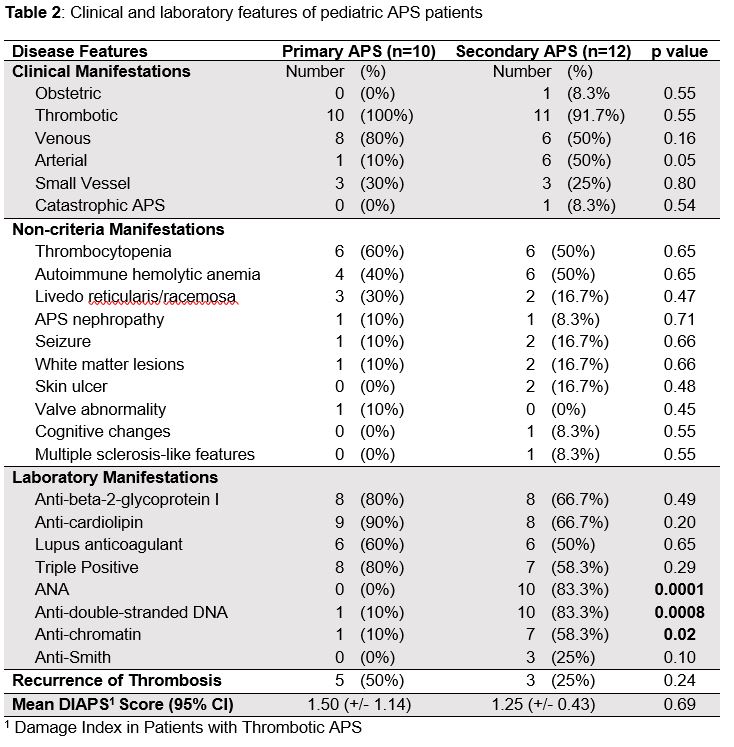Session Information
Session Type: Poster Session B
Session Time: 9:00AM-11:00AM
Background/Purpose: Pediatric antiphospholipid syndrome (APS) is a thromboinflammatory disease classically defined by the presence of circulating antiphospholipid antibodies and either thrombotic events or pregnancy morbidity. Despite its potential to cause significant morbidity in children, pediatric APS is an understudied condition that lacks classification criteria specific to the pediatric age group. The objective of this study was to review a large institution’s experience with pediatric APS in pursuit of a better understanding of the characteristics of children with APS.
Methods: We conducted a retrospective review of pediatric APS at a tertiary referral center. The electronic medical record system was queried for patients aged 21 and younger with a diagnosis of APS from 2000 through 2019. Fifty cases were evaluated further, and 22 were ultimately included in this study based on meeting the revised Sapporo Classification criteria by age 18 or younger.
Results: Twenty-two patients were included with a median age at diagnosis of 16 years and median follow-up of 5.8 years (Table 1). Of the cases, 72.7% were in female patients (Table 1). Secondary APS was slightly more common than primary APS (12 versus 10 cases) and was primarily diagnosed in the context of SLE (10/12 cases). With regards to clinical features, 1 patient had obstetric APS and 21 patients had thrombotic APS (Table 1). Many patients (both primary and secondary APS) had so-called “non-criteria” manifestations of APS includingthrombocytopenia, autoimmune hemolytic anemia, and livedo reticularis/racemosa (Table 2). Patients had durably positive anti-beta-2-glycoprotein I antibodies in 73% of cases, anticardiolipin antibodies in 77%, and lupus anticoagulant in 55%. Secondary APS patients were more likely to be positive for ANA, anti-double-stranded DNA, and anti-chromatin antibodies (Table 2). Two patients were tested for anti-phosphatidylserine/prothrombin antibodies, and both were positive. Both primary and secondary groups had recurrent thromboses without any significant difference in rates between the groups (Table 2), often when patients were subtherapeutic foranticoagulation. Although two patients were treated with aspirin alone, the majority (86%) received anticoagulation with warfarin or heparinoids; 41% (9/22) were treated with both aspirin and anticoagulation. Direct oral anticoagulants and fondaparinux were used in four patients each. The Damage Index in Patients with Thrombotic APS (DIAPS) scores indicate a significant burden of disease (Table 2).
Conclusion: This is the largest case series to date of pediatric APS in a United States population, and thereby provides important context regarding potential phenotypes displayed by children with APS. There was a high prevalence of non-criteria clinical manifestations, highlighting the need to consider these additional characteristics when developing pediatric-specific classification criteria and, most importantly, when considering this rare diagnosis in pediatric practice.
To cite this abstract in AMA style:
Madison J, Gockman K, Knight J. Pediatric APS: Clinical Features, Therapeutic Interventions, and Damage in a Series of 22 Cases [abstract]. Arthritis Rheumatol. 2020; 72 (suppl 10). https://acrabstracts.org/abstract/pediatric-aps-clinical-features-therapeutic-interventions-and-damage-in-a-series-of-22-cases/. Accessed .« Back to ACR Convergence 2020
ACR Meeting Abstracts - https://acrabstracts.org/abstract/pediatric-aps-clinical-features-therapeutic-interventions-and-damage-in-a-series-of-22-cases/


